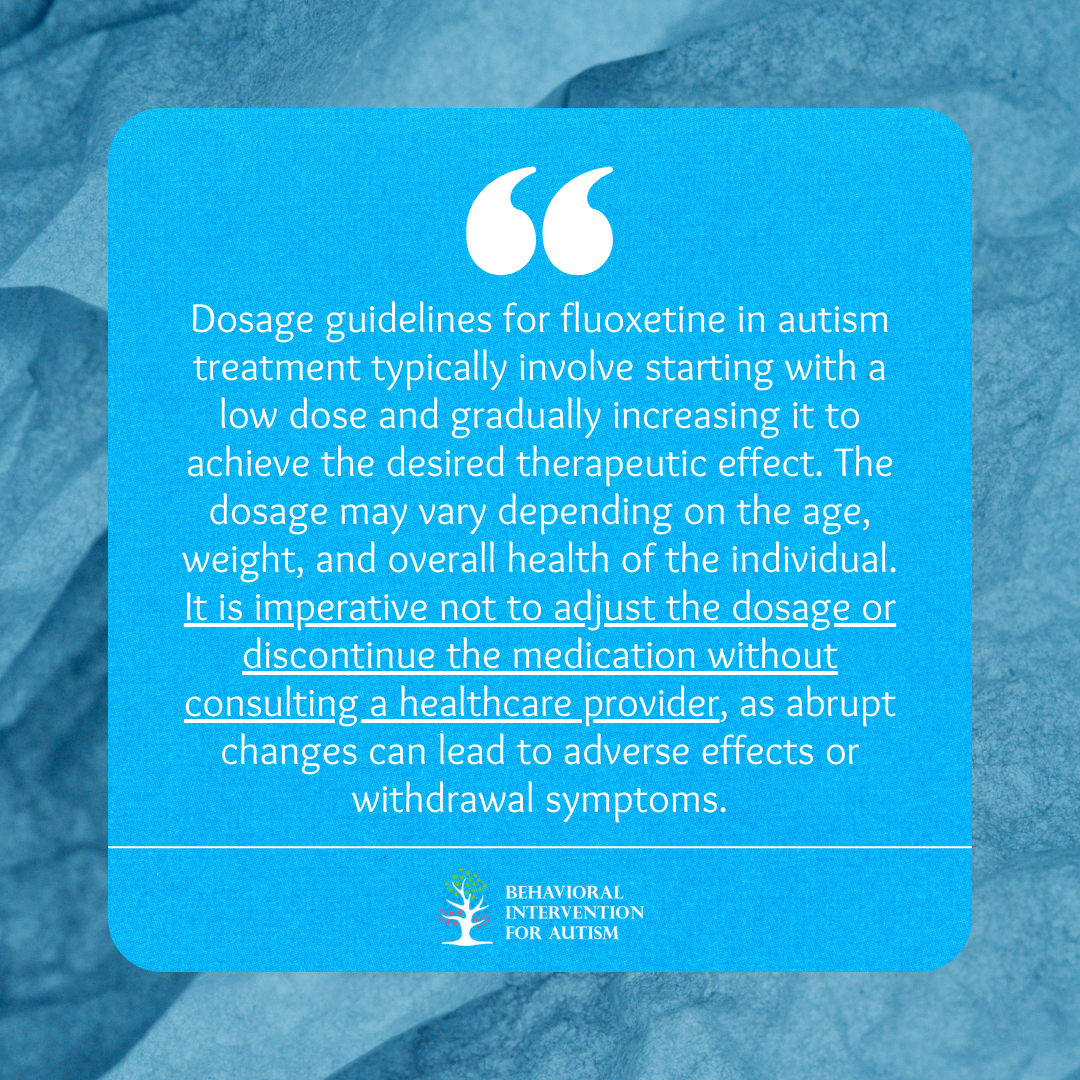
Table of Contents
Autism Spectrum Disorder, commonly referred to as ASD, is a complex neurodevelopmental condition that impacts communication, behavior, and social interaction. Individuals with ASD may display a wide range of symptoms and abilities, leading to the classification of autism as a spectrum disorder. Some common characteristics of ASD include difficulties with social cues, repetitive behaviors, and sensory sensitivities.
What is Fluoxetine and How Does it Work?
Fluoxetine, a type of medication known as a selective serotonin reuptake inhibitor (SSRI), is commonly prescribed to treat various mental health conditions, including depression, anxiety disorders, and obsessive-compulsive disorder (OCD). The primary mechanism of action of fluoxetine involves increasing the levels of serotonin in the brain by blocking its reabsorption, which can help regulate mood and alleviate symptoms associated with mental health disorders.
Condition | Recommended Starting Dose of Fluoxetine |
Depression | 20 mg/day |
Anxiety Disorders | 10 mg/day |
Obsessive-Compulsive Disorder (OCD) | 20 mg/day |
Understanding the fundamentals of ASD and fluoxetine sets the foundation for examining the potential role of fluoxetine as an intervention for individuals with autism and the efficacy of this medication in managing autism symptoms.
Efficacy of Fluoxetine in Managing Autism Symptoms
The efficacy of fluoxetine in managing autism symptoms has been a subject of ongoing debate among healthcare providers and researchers. While some studies have reported positive outcomes, others have highlighted limitations and challenges associated with the use of fluoxetine in individuals with autism.
Aspect | Efficacy |
Repetitive Behaviors | Some studies suggest a reduction in repetitive behaviors with fluoxetine treatment. |
Social Interactions | Improvement in social interactions has been observed in certain cases following fluoxetine therapy. |
Communication Skills | Fluoxetine may contribute to enhanced communication skills and expressive language abilities in individuals with ASD. |
Anxiety Levels | Reduction in anxiety levels has been reported in some individuals with autism receiving fluoxetine treatment. |
It is crucial to weigh the potential benefits of fluoxetine against the possible side effects and individual response variability when considering it as an intervention for autism. Close monitoring by healthcare providers and open communication with caregivers are essential to ensuring the safe and effective use of fluoxetine in managing autism symptoms.

Considerations for Using Fluoxetine
When considering the use of fluoxetine as an intervention for autism, it’s important to be aware of potential side effects that may arise from its use. Additionally, understanding the proper dosage and administration guidelines is essential to ensure the safe and effective use of fluoxetine in individuals with autism.
Possible Side Effects of Fluoxetine
Fluoxetine, like any medication, can elicit certain side effects, especially when used in the context of autism treatment. It is crucial for caregivers and healthcare providers to be vigilant and recognize any adverse reactions that may occur. Some common side effects of fluoxetine in individuals with autism include:
Side Effects | Description |
Nausea | Feeling of queasiness or an urge to vomit |
Insomnia | Difficulty falling or staying asleep |
Headache | Pain or discomfort in the head |
Weight Changes | Fluctuations in weight, both gain and loss |
Emotional Changes | Mood swings, anxiety, or agitation |
Digestive Issues | Upset stomach, diarrhea, or constipation |
Sexual Dysfunction | Changes in libido or sexual function |
Monitoring for these side effects and promptly consulting a healthcare professional if they persist or worsen is crucial for managing the use of fluoxetine in individuals with autism.
Dosage and Administration Guidelines
The dosage and administration of fluoxetine for individuals with autism should be carefully determined by a healthcare provider based on the individual’s specific needs and medical history. It is important to follow the prescribed dosage and administration guidelines to ensure the safe and effective use of fluoxetine in managing autism symptoms.

Ensuring proper administration of fluoxetine, such as taking it at the same time each day and following any specific instructions provided by the healthcare provider, is essential for maximizing the efficacy of the medication in individuals with autism. Regular monitoring and open communication with healthcare professionals can help address any concerns or adjustments needed to optimize the use of fluoxetine in autism intervention.
Pros and Cons of Fluoxetine for Autism
Exploring the use of fluoxetine as an intervention for autism unveils a range of potential benefits and drawbacks that should be carefully considered before initiating treatment.
Benefits of Using Fluoxetine in Autism Treatment
Fluoxetine, commonly known as an SSRI (selective serotonin reuptake inhibitor), has shown promise in addressing certain symptoms associated with autism spectrum disorder (ASD). Here are some potential benefits of using fluoxetine in autism treatment:
Benefit | Description |
Improvement in Repetitive Behaviors | Studies have suggested that fluoxetine may help reduce repetitive behaviors, such as rituals or routines, in individuals with autism. |
Management of Anxiety and Depression | Fluoxetine has been found to alleviate symptoms of anxiety and depression, which are common co-occurring conditions in individuals with autism. |
Enhanced Communication and Social Skills | Some individuals may experience improvements in communication abilities and social interactions with the use of fluoxetine. |
Potential Drawbacks and Risks
While fluoxetine may offer benefits for individuals with autism, it is important to be aware of the potential drawbacks and risks associated with its use. Here are some considerations to keep in mind:
Drawback/Risk | Description |
Side Effects | Common side effects of fluoxetine include nausea, headaches, insomnia, and changes in appetite. It’s essential to monitor for any adverse reactions and consult with a healthcare provider if they persist. |
Behavioral Changes | In some cases, fluoxetine may lead to behavioral changes such as agitation, irritability, or increased impulsivity. Careful observation and communication with healthcare professionals are crucial. |
Interaction with Other Medications | Fluoxetine may interact with other medications, potentially leading to adverse effects or decreased efficacy. It’s important to inform healthcare providers about all medications being taken. |
Weighing the benefits and potential risks of fluoxetine for autism allows individuals, parents, and caregivers to make informed decisions in consultation with healthcare providers to choose the best approach for managing autism symptoms.
Alternative Interventions for Autism
Exploring interventions for autism requires a holistic approach that extends beyond medications like fluoxetine. Behavioral therapies, dietary adjustments, and occupational and sensory therapies can significantly support individuals with autism.
Behavioral Therapies
Behavioral therapies are a cornerstone in the treatment of autism spectrum disorder (ASD). These therapies are designed to address specific behaviors and skill deficits commonly associated with autism. Applied Behavior Analysis (ABA) is one of the most widely used behavioral interventions for individuals with ASD. ABA uses techniques such as positive reinforcement to encourage desired behaviors and reduce challenging behaviors.
Dietary Approaches
Dietary approaches involve making specific changes to an individual’s diet to potentially improve symptoms associated with autism. While the relationship between diet and autism is still being researched, some families have reported positive outcomes from dietary modifications. Common dietary approaches include the gluten-free and casein-free (GFCF) diet, which involves eliminating gluten and dairy products from the diet. Additionally, some individuals may benefit from nutritional supplements like omega-3 fatty acids and probiotics.
Dietary Approach | Description |
Gluten-Free and Casein-Free (GFCF) Diet | Eliminates foods containing gluten and casein to address potential dietary sensitivities. |
Ketogenic Diet | High-fat, low-carbohydrate diet that may have positive effects on behavior and cognition. |
Nutritional Supplements | Includes vitamins, minerals, and probiotics that may support overall health and well-being. |
Occupational and Sensory Therapies
Occupational and sensory therapies focus on addressing sensory sensitivities and improving daily living skills for individuals with autism. Occupational therapy helps individuals develop functional skills related to self-care, play, and social interactions. Sensory therapies aim to regulate sensory processing difficulties commonly observed in individuals with ASD, such as hypersensitivity or hyposensitivity to sensory stimuli.
Incorporating behavioral therapies, dietary approaches, and occupational and sensory therapies provides individuals with autism comprehensive support tailored to their needs. When combined with medical treatments like fluoxetine, these interventions help create a holistic autism management plan that addresses various aspects of well-being.

Explore Personalized Support for Autism
Fluoxetine, often prescribed to manage anxiety and repetitive behaviors in individuals with autism, may not be suitable for everyone. Finding the right approach to support each individual’s unique needs is crucial. Behavioral Intervention For Autism provides specialized ABA programs in Florida, designed to complement and enhance each person’s journey with high-quality, personalized care. Our team is committed to delivering effective interventions that make a lasting impact. Reach out to us today to discover how we can work together to provide the best support for your loved one.
- 9 Common Obsessions of Children With Autism You Should Know - February 25, 2025
- What is Neurodiversity? A Guide to Embracing Differences - February 25, 2025
- Understanding Hyperfocus in Autism: What It Means and Why It Happens - February 25, 2025
